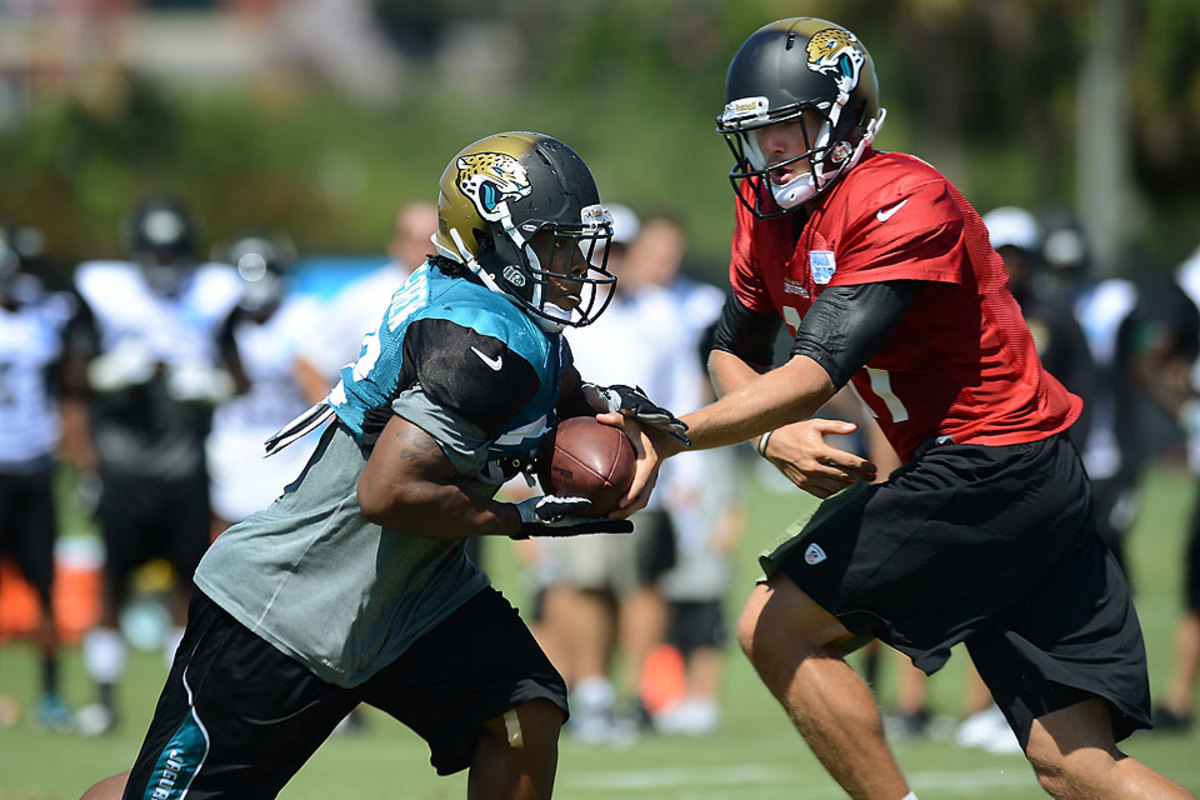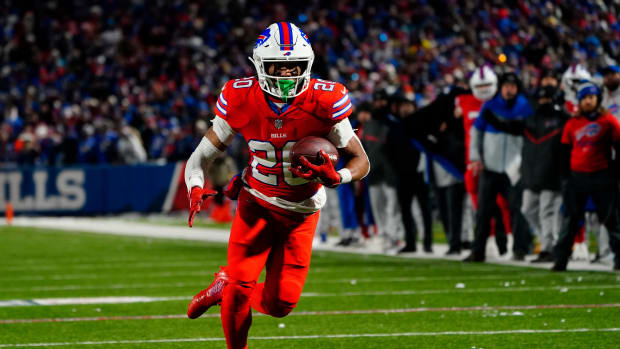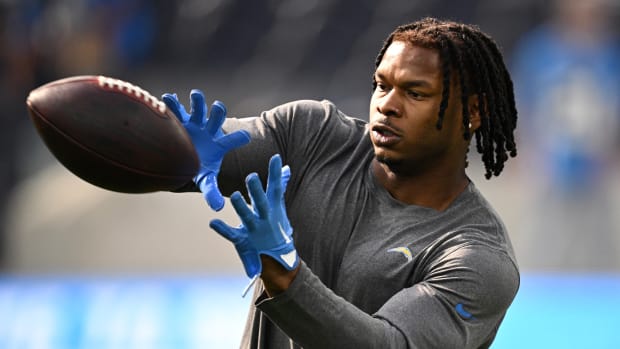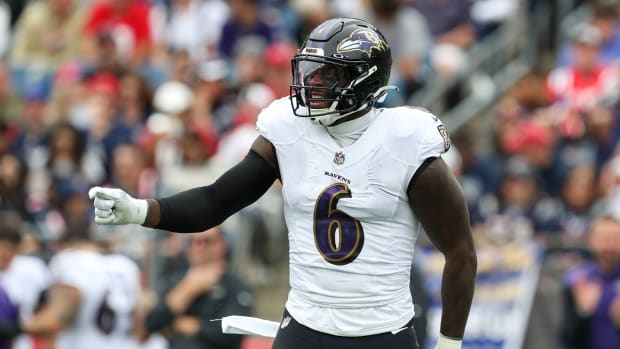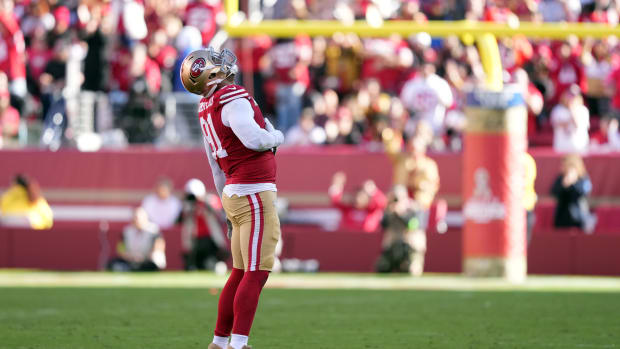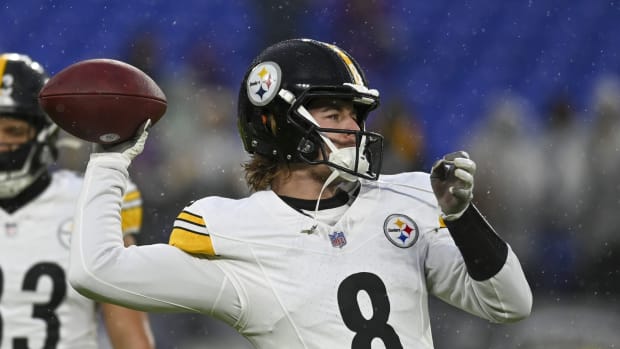Jaguars Preview: A Mustache-Powered Makeover
It’s amazing how much sway a mustache can hold. The luxurious handlebars spiraling out from the space between Shahid Khan’s upper lip and nose have accentuated the owner’s vibrant charm, giving him invaluable benefit of the doubt around Jacksonville. With the fan base still on his side, Khan has been able to make the type of smart, long-term decisions that, though unpopular, give the league’s 32nd most valuable franchise its best shot at growth.
One of those decisions was to hire first-time general manager Dave Caldwell and first-time head coach Gus Bradley. The Caldwell hiring gives Jacksonville a respected former executive from Bill Polian’s tree in Indianapolis and Thomas Dimitroff’s tree in Atlanta. The Bradley hiring was Khan’s tacit admission that he made a mistake in anointing Mike Mularkey to the same position in 2012.
Khan has given Caldwell enough autonomy to make strictly football-based decisions, leaving the team’s marketing department as a totally separate entity. This meant no Tim Tebow homecoming, no reaching for an unqualified quarterback early in the draft (the Jags used the No. 2 overall pick on offensive tackle Luke Joeckel) and no high-risk contracts given to flawed free agents. Khan’s day-to-day focus, meanwhile, has ostensibly been on the business side of things. Talks of regular home games in London are heating up, snazzy new uniforms have already been sewn and an agreement with city officials to undertake $63 million in enhancements to tarp-infested EverBank Field was reached in June.
The early stages of a long-term plan can be painful. The Jaguars still lack playmakers, which is why a third straight double-digit loss season appears inevitable. And even with new home game promotions, generating revenue will remain a challenge for this pro club in a college football hotbed. Most of the nation will not be paying attention, either; the Jaguars are slated for just one prime time game this season: the obligatory Thursday Night contest on NFL Network (Dec. 5 at home against Houston).
But it’s reassuring to see Khan taking a patient approach with this team. He should be able to carry on unencumbered by fan pressure for at least another year or two—just as long as he doesn’t shave the mustache.
DEFENSE
New coach Gus Bradley’s expertise is on D, but he may not have the personnel to run his hybrid schemes. (Phelan M. Ebenhack/AP)
We’ll start with the side of the ball that Gus Bradley cut his teeth on. Though Bradley, 47, concocted several unique hybrid attacks from sub-packages as Seattle’s defensive coordinator, his 4-3 scheme there was known for staunch single-high zone coverages that were squeezed with press-man concepts from the outside corners. While that highly effective scheme helped land Bradley this job, it probably won’t be seen in Jacksonville
With the Seahawks, Bradley had the league’s stingiest cornerback duo (Richard Sherman and Brandon Browner). Here he might have the league’s worst cornerbacking group. The expected No. 1 is rookie Dwayne Gratz, who wasn’t taken until the third round. Scouts like the 5-11, 201-pounder’s closing quickness and aggression, though they worry he can be baited into making bad decisions. The No. 2 corner might be Marcus Trufant, which would be fine if this were 2006. The 32-year-old ex-Seahawk has started just six games over the past two years and operated primarily out the slot last season.
More on the Jaguars
3Q Interview: Maurice Jones-Drew on his 2012 holdout and his recovery from injury.
3Q Interview: Offensive coordinator Jedd Fisch, the man to save Blaine Gabbert.
3Q Interview: High-profile rookie Denard Robinson on the “offensive weapon” tag.
Most likely, that’s where Trufant will wind up playing this season, though it’s hard to figure who could then start outside as the No. 2. Former Texan Alan Ball, who is versatile in space but vulnerable in man coverage, would seem to be the front-runner. He’s never been much more than a dime back, though. Second-year man Mike Harris, who is forceful in support but still developing his awareness in coverage, can also play inside or outside. Undrafted third-year pro Kevin Rutland is also in the mix.
Jacksonville’s safety position might be a little more fruitful, depending on how quickly No. 33 overall pick Jonathan Cyprien, who did not face top-level competition at Florida International, can acclimate to the pro game. Cyprien also played a somewhat restricting pure strong safety role at FIU, though many believe he has the range and backpedal dexterity to be an assertive deep safety.
Starting alongside Cyprien will be Dwight Lowery, a puzzle piece sixth-year pro who wound up missing about half of last season with a foot injury. Providing depth is third-year pro Chris Prosinski, who showed up positively on film a time or two last year but, overall, can be deemed “nothing special.” There’s also sixth-round rookie Josh Evans.
With such a feeble secondary, Jacksonville’s only real chance at stopping the pass in 2013 will be through pressure on the quarterback. The Jaguars might employ a quartet of defensive ends. Two of them are notably accomplished: Jason Babin and Jeremy Mincey. Both can explode around the corner and, with nimble low leverage, bull through off-balance blockers from a wide-nine alignment. The other two are younger but still uncertain products. Last year’s second-round pick, Andre Branch, has been completely forgettable through 13 games. Former first-rounder Tyson Alualu is moderately quick and always relentless, but he’s learning some new mechanics after playing defensive tackle his first three years. That will be an adjustment on running downs; in passing situations, Alualu will slide back to his usual three-technique spot.
Given the shortcomings in the secondary, Jacksonville’s best hope for stopping the passing game is pressure on the quarterback from Mincey and the D-line. (Jeff Zelevansky/Getty Images)
Assuming the ends do their part, run defense as a whole should be a strength of Jacksonville’s. Caldwell made two excellent under-the-radar free-agent signings in ex-Buc Roy Miller and ex-Titan Sen’Derrick Marks. Miller has good initial quickness for a squatty 310-pounder. He’s capable of crossing the center’s face from a nose-shade alignment, which can be tremendously disruptive to an offensive line’s interior movement and double-team constructs. Marks does not have great foot quickness, but he’s an adept lateral mover and a good early-down plugger. Caldwell also replenished the depth at defensive tackle, signing discarded Patriots Brandon Deaderick and Kyle Love. They’ll compete with serviceable backup run defender D’Anthony Smith for playing time.
Behind the clogging defensive tackles is an acceptable linebacking unit, with Paul Posluszny in the middle and Russell Allen and Geno Hayes on the outsides. But it’s a unit that’s thin on the back end, as last year’s fifth-round pick, Brandon Marshall, is the only drafted reserve (not counting recently signed ex-Chief Andy Studebaker, who has a slim shot at making the final roster). Of course, the questionable depth will only be a problem if someone gets hurt. It’s somewhat reassuring that none of these starting linebackers, including the once-injury-prone Posluszny, has missed significant action over the last two years.
Posluszny is clearly the leader. He’s active and alert in all phases, including coverage. Hopefully that will stay true as he adapts to more lateral techniques in Bradley’s four-man underneath concepts. In previous coordinator Mel Tucker’s two-high zone scheme, Posluszny got used to running vertically down the seams.
OFFENSE
Blaine Gabbert has the starting job again, but he has much to work on if he is to be the long-term answer. (Jeff Zelevansky/Getty Images)
It’s rarely good when a team enters training camp amid a quarterback competition. And it’s never good when both competitors have previous starting experience. That means both have flaws that are glaring enough to have put their starting status in jeopardy. Which is why, regardless of who wins the job (in this case, Blaine Gabbert), pending issues will implicitly leave the position forever “subject to change.”
The decision on a starter may have come down in part to how Caldwell, Bradley and new 37-year-old offensive coordinator Jedd Fisch (a former NFL journeyman assistant who, most recently, coordinated the offense at the University of Miami) felt about Gabbert in the abstract. They aren’t the ones who drafted the 6-4 Missouri product 10th overall in 2011, but they understand that, all other things being equal, the 23-year-old’s development presents greater long-term value than the 28-year-old Chad Henne’s.
But as the season progresses, will they think the lively-armed Gabbert actually can develop? He showed glimpses of improvement in a watered-down offense early last season but ultimately got himself benched because of the same problems that have plagued him since coming out of Missouri: mainly a lack of awareness and toughness in the pocket. Gabbert has a bad tendency to anticipate and even stare at the rush. Many believe this is something that can’t be coached out of a player. What can be coached is pre-snap awareness, which Gabbert must develop if he’s even to be considered a long-term prospect. His oversights in protection adjustments have been embarrassing at times (see graphic below).
Henne has very good pocket toughness, but being a willing passer with bodies around him doesn’t make him an always effective passer in those situations. Erratic ball placement has driven many of the costly interceptions that have steered Henne’s career to the sideline. His accuracy must be more consistent.
Quarterbacking this offense means being saddled with unappetizing options in the passing game. Fisch, who will have trouble going at the breakneck tempo he prefers, is poised to encounter one of the greatest challenges an NFL play-caller can face: overcoming a shortage of talent at wide receiver. This sort of problem is not supposed to hound a team that drafted a wideout fifth overall the previous year. But after seeing Justin Blackmon continuously lumber off the line and through rounded-off routes last season, it’s hard to envision the 6-1, 210-pounder ever being more than a No. 2 possession-type target (and this is to say nothing of his off-field troubles, which have already earned him a four-game suspension to start this season).
For Blackmon to have any chance at success, Fisch will have to frequently put him in motion so that he can come off the snap with momentum. Blackmon was far more effective on these sorts of designs last season. For field-stretching, the Jaguars will turn to Cecil Shorts, even though the third-year pro is really more equipped for the slot. That’s where quick fourth-round rookie Ace Sanders is expected to play, likely as the No. 3 ahead of Jordan Shipley.
The Jags at least have a reliable tight end to fall back on, though it’s difficult to not see faint glimmers of unrecognized potential when watching mammoth, short-intermediate pass-catcher Marcedes Lewis. The firm-blocking eighth-year pro brings modest position versatility to the pass game—flexing to the slot and, occasionally, wide—but that may essentially be rendered moot given how the absence of experienced depth behind Lewis could ultimately discourage dual tight end sets in 2013.
Bradley enjoyed success as a Seahawks coordinator but has his work cut out for him as top man in Jacksonville. (John Raoux/AP)
The common assumption about a team that’s low on passing weapons is it’ll just be a run-first offense. But the Jaguars have shown in recent years that a dominant ground game alone rarely leads to major success in today’s NFL. In its five seasons since last finishing over .500, Jacksonville’s rushing attack has ranked in the top 12 three times, with lone superstar Maurice Jones-Drew topping 1,300 yards each time.
It remains to be seen whether Jones-Drew can continue being the same dynamic bowling ball of a runner this season, as he’s coming off a very serious Lisfranc (foot) injury. The Jaguars have no contingency plans if the 28-year-old suddenly fades; diminutive change-of-pace back Justin Forsett is next on the depth chart, with uninspiring young journeyman Jordan Todman behind him. There is, however, an intriguing fifth-round rookie to consider: former Michigan quarterback Denard Robinson, whom the Jaguars have officially named their “offensive weapon” (a moniker that could come to spawn a new position title in pro football). Robinson will likely operate primarily from the backfield, with touches coming in a variety of forms.
While having an unpolished utility rookie as your only source of true dimension on offense might seem somewhat discouraging, the Jags can take solace in the fact that their front five should have more control over the trenches in 2013. Eugene Monroe has been adequate at left tackle, but it’s just a matter of time before he is displaced by Luke Joeckel. For now, Joeckel will take over for the uncoordinated Cameron Bradfield at right tackle, transforming Jacksonville’s greatest weakness into a strength.
Inside, center Brad Meester continues to stay above water, but the 36-year-old’s power declines a bit each year. Mike Brewster is Meester’s top backup, though the undrafted second-year pro’s primary position is guard. That starting position on the left side will be manned by Will Rackley (back from a 2012 ankle injury that surprisingly landed him on IR last August). On the right side is Uche Nwaneri, a big but lumbering mover.
SPECIAL TEAMS
Josh Scobee remains one of the league’s best kickers, not just on field goals (25 of 28 last season) but also kickoffs. Punter Bryan Anger finished seventh in net average in 2012 (40.8), and set a rookie record with a 47.8 gross average (minimum 15 punts). Sadly, he’s still a severe underachiever considering that previous GM Gene Smith drafted him in the THIRD ROUND! (Jags fans will be forever nonplussed over that.) Denard Robinson is expected to electrify a return game that, last season, was not plugged in.
BOTTOM LINE
This team simply does not have enough talent to contend for anything other than another top-10 pick. Don’t be surprised if half of this roster looks completely different next year.
Andy Benoit is diving deep into each team’s prospects for 2013. Read what he’s done so far.
































